Strategic Management Report: Comprehensive Analysis of Hilton Hotels
VerifiedAdded on 2020/04/21
|21
|4933
|101
Report
AI Summary
This report provides a comprehensive strategic management analysis of Hilton Hotels. It begins with an executive summary and an overview of the company, followed by an in-depth examination of the hospitality industry, including Porter's Five Forces. The report details Hilton's growth pattern, external factors through PEST analysis, and internal factors such as core competencies and value chain analysis. A SWOT analysis is presented, highlighting strengths, weaknesses, opportunities, and threats. Furthermore, the report explores Hilton's business and corporate-level strategies, strategic direction, and provides future strategy recommendations. The conclusion summarizes the key findings and strategic insights, offering a thorough understanding of Hilton's position and strategic approach within the global hospitality market. The report provides a strong basis for understanding the company's competitive advantage, strategic direction, and future prospects.
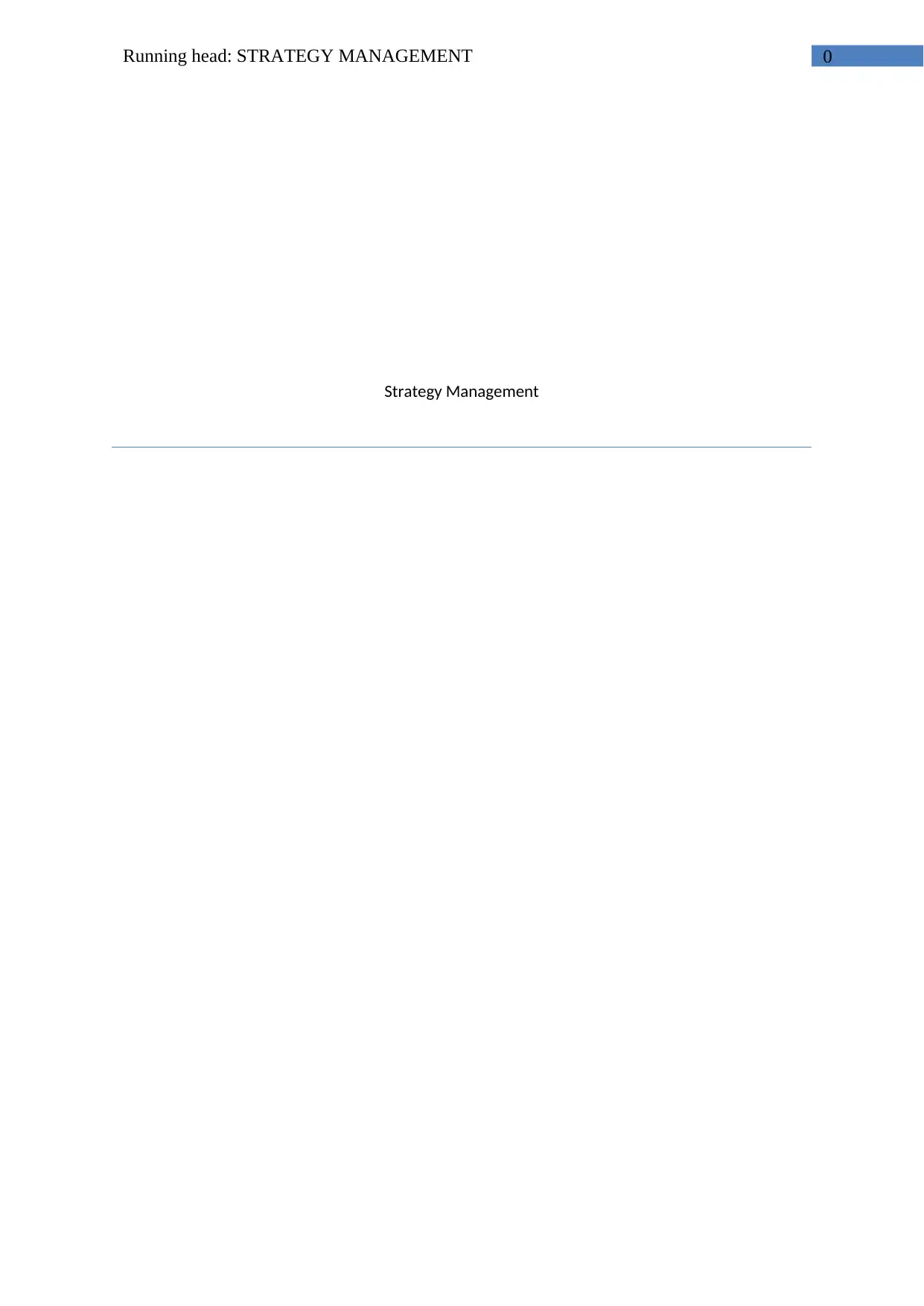
0Running head: STRATEGY MANAGEMENT
Strategy Management
Strategy Management
Paraphrase This Document
Need a fresh take? Get an instant paraphrase of this document with our AI Paraphraser
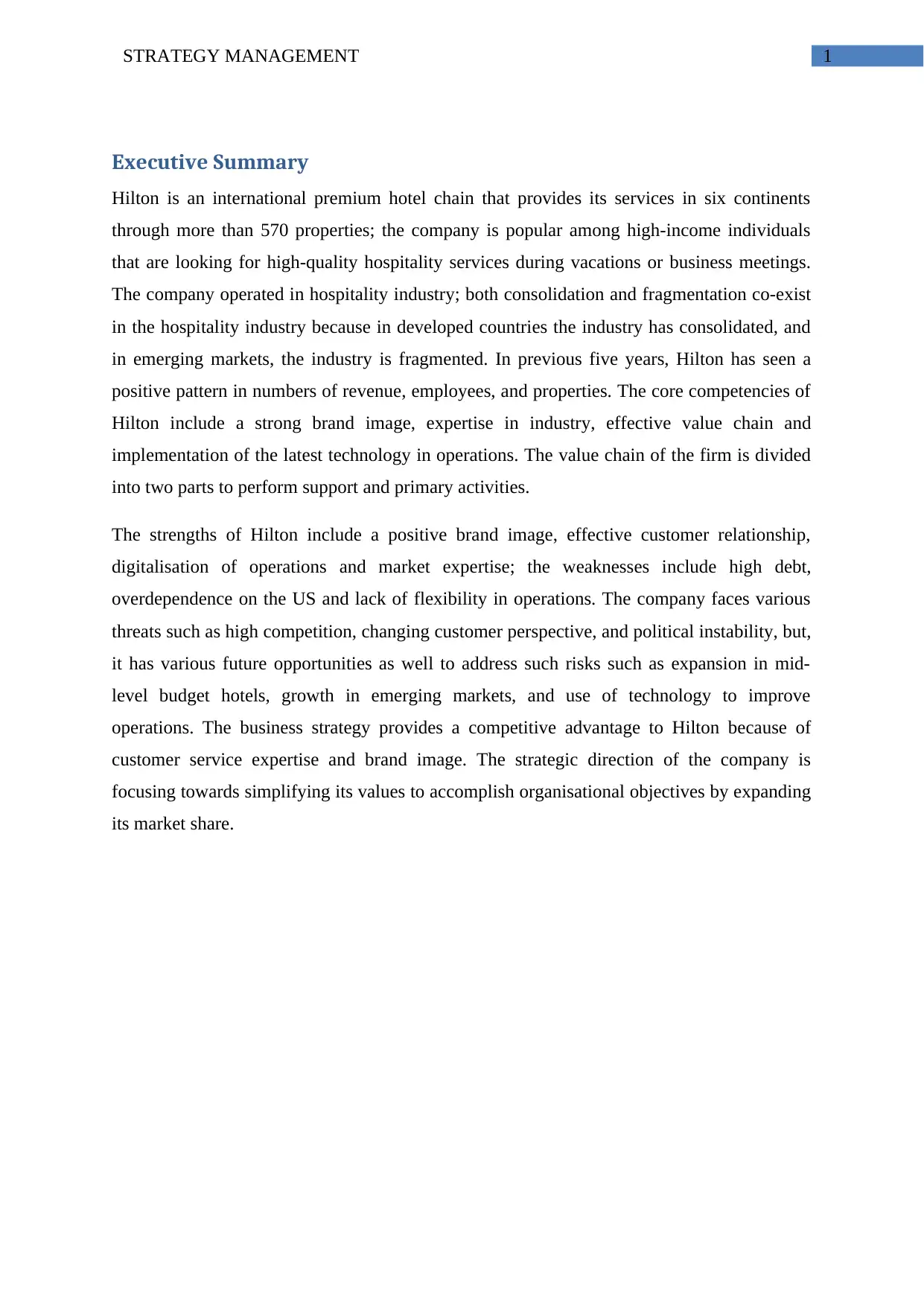
1STRATEGY MANAGEMENT
Executive Summary
Hilton is an international premium hotel chain that provides its services in six continents
through more than 570 properties; the company is popular among high-income individuals
that are looking for high-quality hospitality services during vacations or business meetings.
The company operated in hospitality industry; both consolidation and fragmentation co-exist
in the hospitality industry because in developed countries the industry has consolidated, and
in emerging markets, the industry is fragmented. In previous five years, Hilton has seen a
positive pattern in numbers of revenue, employees, and properties. The core competencies of
Hilton include a strong brand image, expertise in industry, effective value chain and
implementation of the latest technology in operations. The value chain of the firm is divided
into two parts to perform support and primary activities.
The strengths of Hilton include a positive brand image, effective customer relationship,
digitalisation of operations and market expertise; the weaknesses include high debt,
overdependence on the US and lack of flexibility in operations. The company faces various
threats such as high competition, changing customer perspective, and political instability, but,
it has various future opportunities as well to address such risks such as expansion in mid-
level budget hotels, growth in emerging markets, and use of technology to improve
operations. The business strategy provides a competitive advantage to Hilton because of
customer service expertise and brand image. The strategic direction of the company is
focusing towards simplifying its values to accomplish organisational objectives by expanding
its market share.
Executive Summary
Hilton is an international premium hotel chain that provides its services in six continents
through more than 570 properties; the company is popular among high-income individuals
that are looking for high-quality hospitality services during vacations or business meetings.
The company operated in hospitality industry; both consolidation and fragmentation co-exist
in the hospitality industry because in developed countries the industry has consolidated, and
in emerging markets, the industry is fragmented. In previous five years, Hilton has seen a
positive pattern in numbers of revenue, employees, and properties. The core competencies of
Hilton include a strong brand image, expertise in industry, effective value chain and
implementation of the latest technology in operations. The value chain of the firm is divided
into two parts to perform support and primary activities.
The strengths of Hilton include a positive brand image, effective customer relationship,
digitalisation of operations and market expertise; the weaknesses include high debt,
overdependence on the US and lack of flexibility in operations. The company faces various
threats such as high competition, changing customer perspective, and political instability, but,
it has various future opportunities as well to address such risks such as expansion in mid-
level budget hotels, growth in emerging markets, and use of technology to improve
operations. The business strategy provides a competitive advantage to Hilton because of
customer service expertise and brand image. The strategic direction of the company is
focusing towards simplifying its values to accomplish organisational objectives by expanding
its market share.
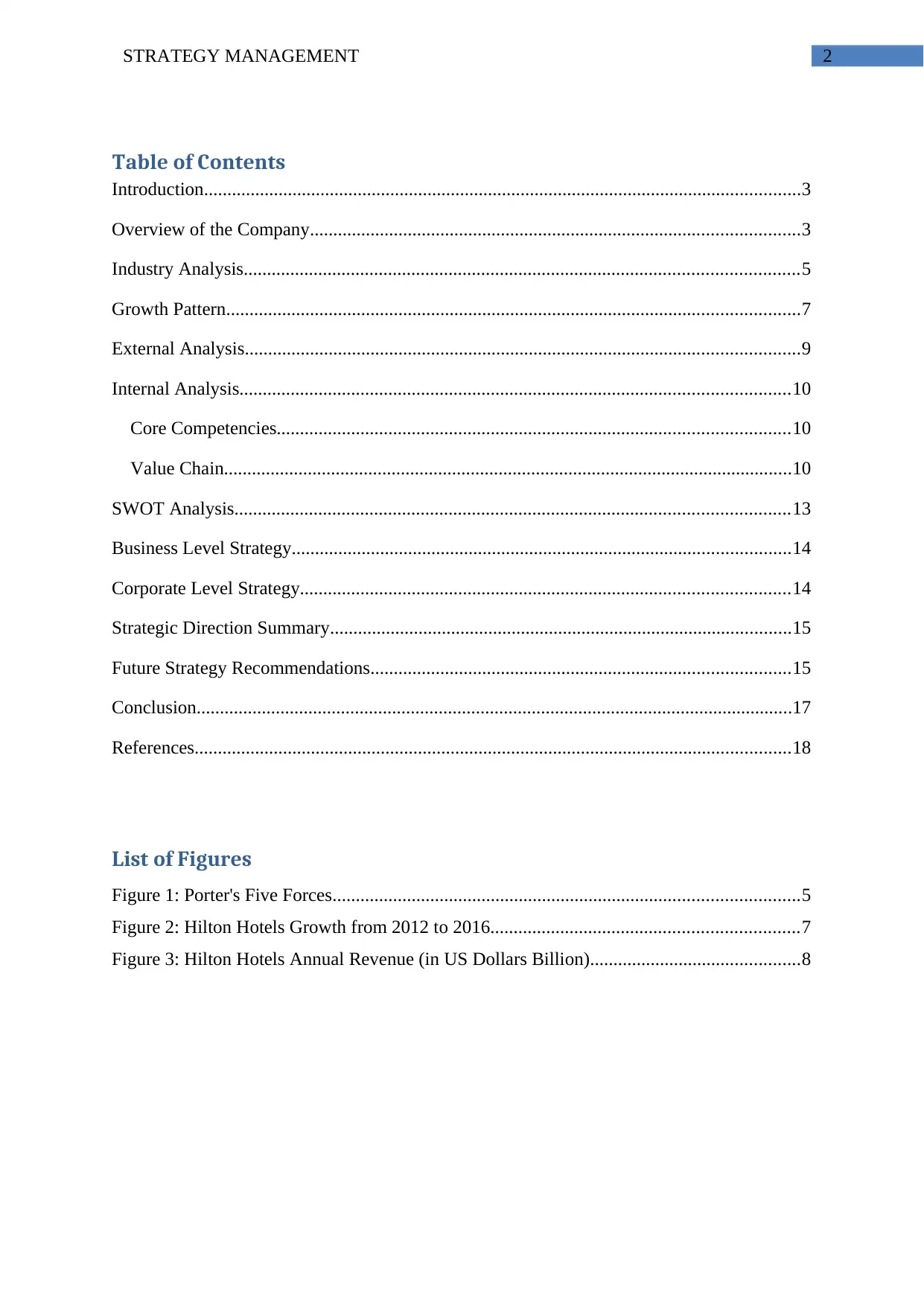
2STRATEGY MANAGEMENT
Table of Contents
Introduction................................................................................................................................3
Overview of the Company.........................................................................................................3
Industry Analysis.......................................................................................................................5
Growth Pattern...........................................................................................................................7
External Analysis.......................................................................................................................9
Internal Analysis......................................................................................................................10
Core Competencies..............................................................................................................10
Value Chain..........................................................................................................................10
SWOT Analysis.......................................................................................................................13
Business Level Strategy...........................................................................................................14
Corporate Level Strategy.........................................................................................................14
Strategic Direction Summary...................................................................................................15
Future Strategy Recommendations..........................................................................................15
Conclusion................................................................................................................................17
References................................................................................................................................18
List of Figures
Figure 1: Porter's Five Forces....................................................................................................5
Figure 2: Hilton Hotels Growth from 2012 to 2016..................................................................7
Figure 3: Hilton Hotels Annual Revenue (in US Dollars Billion).............................................8
Table of Contents
Introduction................................................................................................................................3
Overview of the Company.........................................................................................................3
Industry Analysis.......................................................................................................................5
Growth Pattern...........................................................................................................................7
External Analysis.......................................................................................................................9
Internal Analysis......................................................................................................................10
Core Competencies..............................................................................................................10
Value Chain..........................................................................................................................10
SWOT Analysis.......................................................................................................................13
Business Level Strategy...........................................................................................................14
Corporate Level Strategy.........................................................................................................14
Strategic Direction Summary...................................................................................................15
Future Strategy Recommendations..........................................................................................15
Conclusion................................................................................................................................17
References................................................................................................................................18
List of Figures
Figure 1: Porter's Five Forces....................................................................................................5
Figure 2: Hilton Hotels Growth from 2012 to 2016..................................................................7
Figure 3: Hilton Hotels Annual Revenue (in US Dollars Billion).............................................8
⊘ This is a preview!⊘
Do you want full access?
Subscribe today to unlock all pages.

Trusted by 1+ million students worldwide
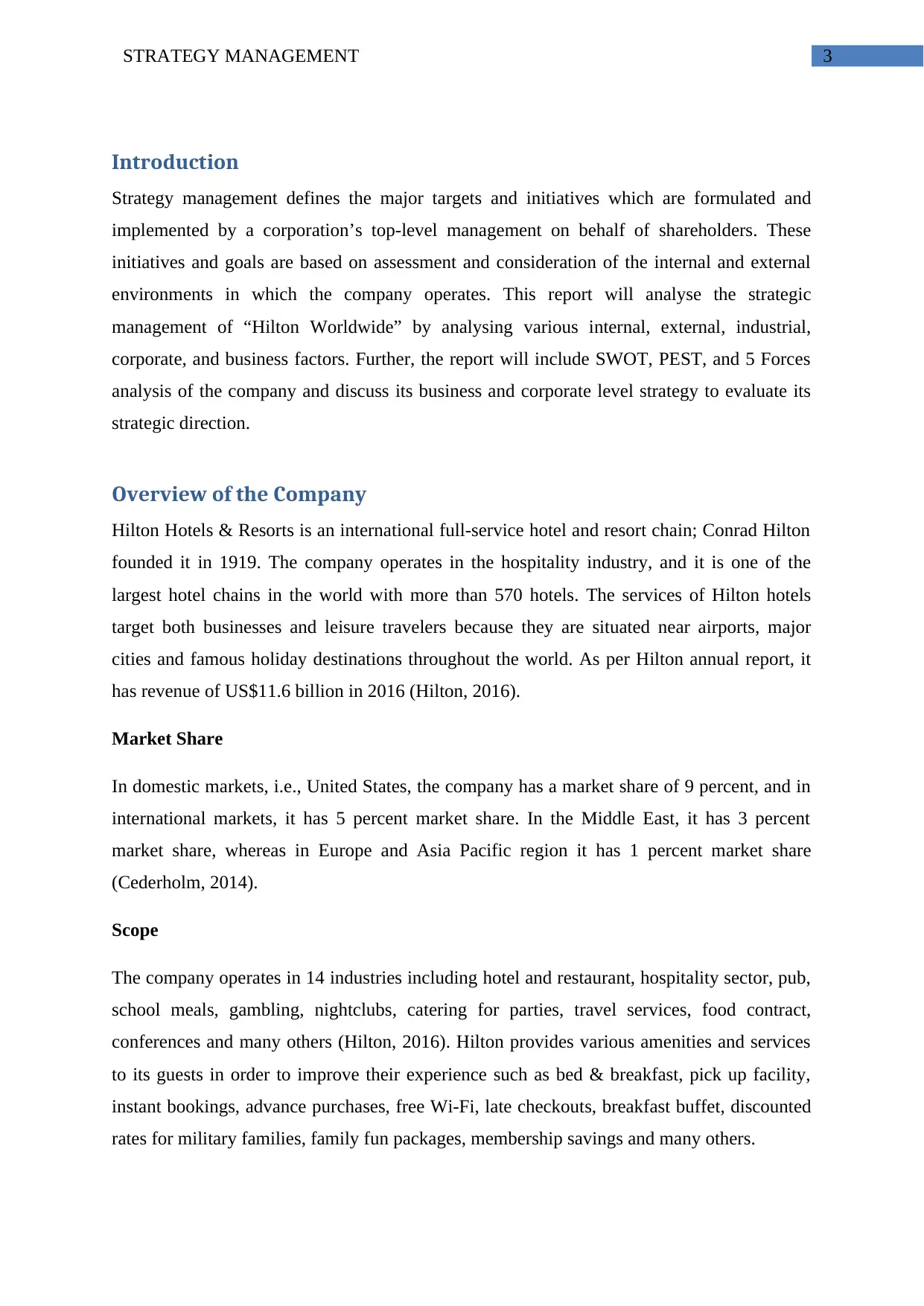
3STRATEGY MANAGEMENT
Introduction
Strategy management defines the major targets and initiatives which are formulated and
implemented by a corporation’s top-level management on behalf of shareholders. These
initiatives and goals are based on assessment and consideration of the internal and external
environments in which the company operates. This report will analyse the strategic
management of “Hilton Worldwide” by analysing various internal, external, industrial,
corporate, and business factors. Further, the report will include SWOT, PEST, and 5 Forces
analysis of the company and discuss its business and corporate level strategy to evaluate its
strategic direction.
Overview of the Company
Hilton Hotels & Resorts is an international full-service hotel and resort chain; Conrad Hilton
founded it in 1919. The company operates in the hospitality industry, and it is one of the
largest hotel chains in the world with more than 570 hotels. The services of Hilton hotels
target both businesses and leisure travelers because they are situated near airports, major
cities and famous holiday destinations throughout the world. As per Hilton annual report, it
has revenue of US$11.6 billion in 2016 (Hilton, 2016).
Market Share
In domestic markets, i.e., United States, the company has a market share of 9 percent, and in
international markets, it has 5 percent market share. In the Middle East, it has 3 percent
market share, whereas in Europe and Asia Pacific region it has 1 percent market share
(Cederholm, 2014).
Scope
The company operates in 14 industries including hotel and restaurant, hospitality sector, pub,
school meals, gambling, nightclubs, catering for parties, travel services, food contract,
conferences and many others (Hilton, 2016). Hilton provides various amenities and services
to its guests in order to improve their experience such as bed & breakfast, pick up facility,
instant bookings, advance purchases, free Wi-Fi, late checkouts, breakfast buffet, discounted
rates for military families, family fun packages, membership savings and many others.
Introduction
Strategy management defines the major targets and initiatives which are formulated and
implemented by a corporation’s top-level management on behalf of shareholders. These
initiatives and goals are based on assessment and consideration of the internal and external
environments in which the company operates. This report will analyse the strategic
management of “Hilton Worldwide” by analysing various internal, external, industrial,
corporate, and business factors. Further, the report will include SWOT, PEST, and 5 Forces
analysis of the company and discuss its business and corporate level strategy to evaluate its
strategic direction.
Overview of the Company
Hilton Hotels & Resorts is an international full-service hotel and resort chain; Conrad Hilton
founded it in 1919. The company operates in the hospitality industry, and it is one of the
largest hotel chains in the world with more than 570 hotels. The services of Hilton hotels
target both businesses and leisure travelers because they are situated near airports, major
cities and famous holiday destinations throughout the world. As per Hilton annual report, it
has revenue of US$11.6 billion in 2016 (Hilton, 2016).
Market Share
In domestic markets, i.e., United States, the company has a market share of 9 percent, and in
international markets, it has 5 percent market share. In the Middle East, it has 3 percent
market share, whereas in Europe and Asia Pacific region it has 1 percent market share
(Cederholm, 2014).
Scope
The company operates in 14 industries including hotel and restaurant, hospitality sector, pub,
school meals, gambling, nightclubs, catering for parties, travel services, food contract,
conferences and many others (Hilton, 2016). Hilton provides various amenities and services
to its guests in order to improve their experience such as bed & breakfast, pick up facility,
instant bookings, advance purchases, free Wi-Fi, late checkouts, breakfast buffet, discounted
rates for military families, family fun packages, membership savings and many others.
Paraphrase This Document
Need a fresh take? Get an instant paraphrase of this document with our AI Paraphraser
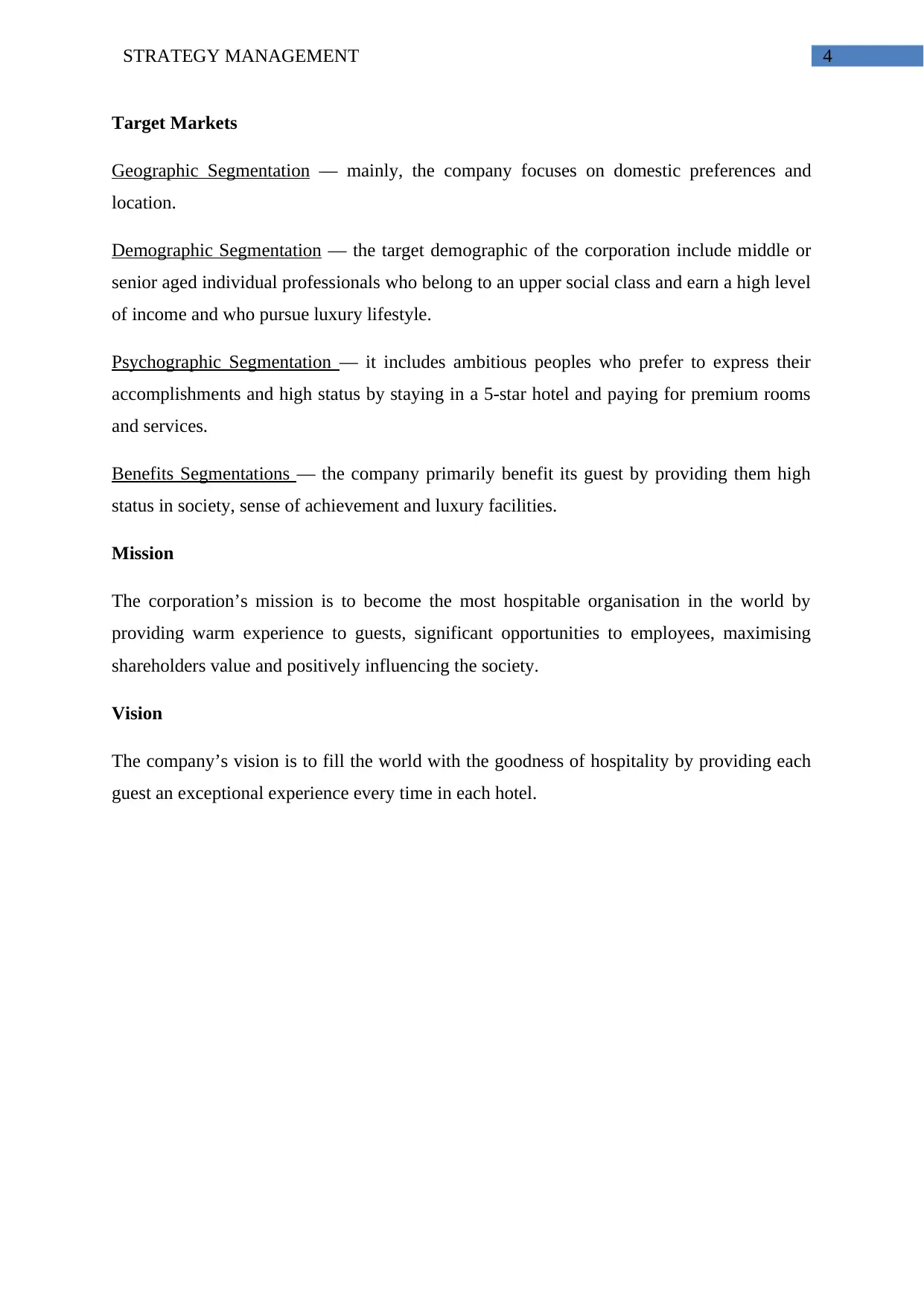
4STRATEGY MANAGEMENT
Target Markets
Geographic Segmentation — mainly, the company focuses on domestic preferences and
location.
Demographic Segmentation — the target demographic of the corporation include middle or
senior aged individual professionals who belong to an upper social class and earn a high level
of income and who pursue luxury lifestyle.
Psychographic Segmentation — it includes ambitious peoples who prefer to express their
accomplishments and high status by staying in a 5-star hotel and paying for premium rooms
and services.
Benefits Segmentations — the company primarily benefit its guest by providing them high
status in society, sense of achievement and luxury facilities.
Mission
The corporation’s mission is to become the most hospitable organisation in the world by
providing warm experience to guests, significant opportunities to employees, maximising
shareholders value and positively influencing the society.
Vision
The company’s vision is to fill the world with the goodness of hospitality by providing each
guest an exceptional experience every time in each hotel.
Target Markets
Geographic Segmentation — mainly, the company focuses on domestic preferences and
location.
Demographic Segmentation — the target demographic of the corporation include middle or
senior aged individual professionals who belong to an upper social class and earn a high level
of income and who pursue luxury lifestyle.
Psychographic Segmentation — it includes ambitious peoples who prefer to express their
accomplishments and high status by staying in a 5-star hotel and paying for premium rooms
and services.
Benefits Segmentations — the company primarily benefit its guest by providing them high
status in society, sense of achievement and luxury facilities.
Mission
The corporation’s mission is to become the most hospitable organisation in the world by
providing warm experience to guests, significant opportunities to employees, maximising
shareholders value and positively influencing the society.
Vision
The company’s vision is to fill the world with the goodness of hospitality by providing each
guest an exceptional experience every time in each hotel.
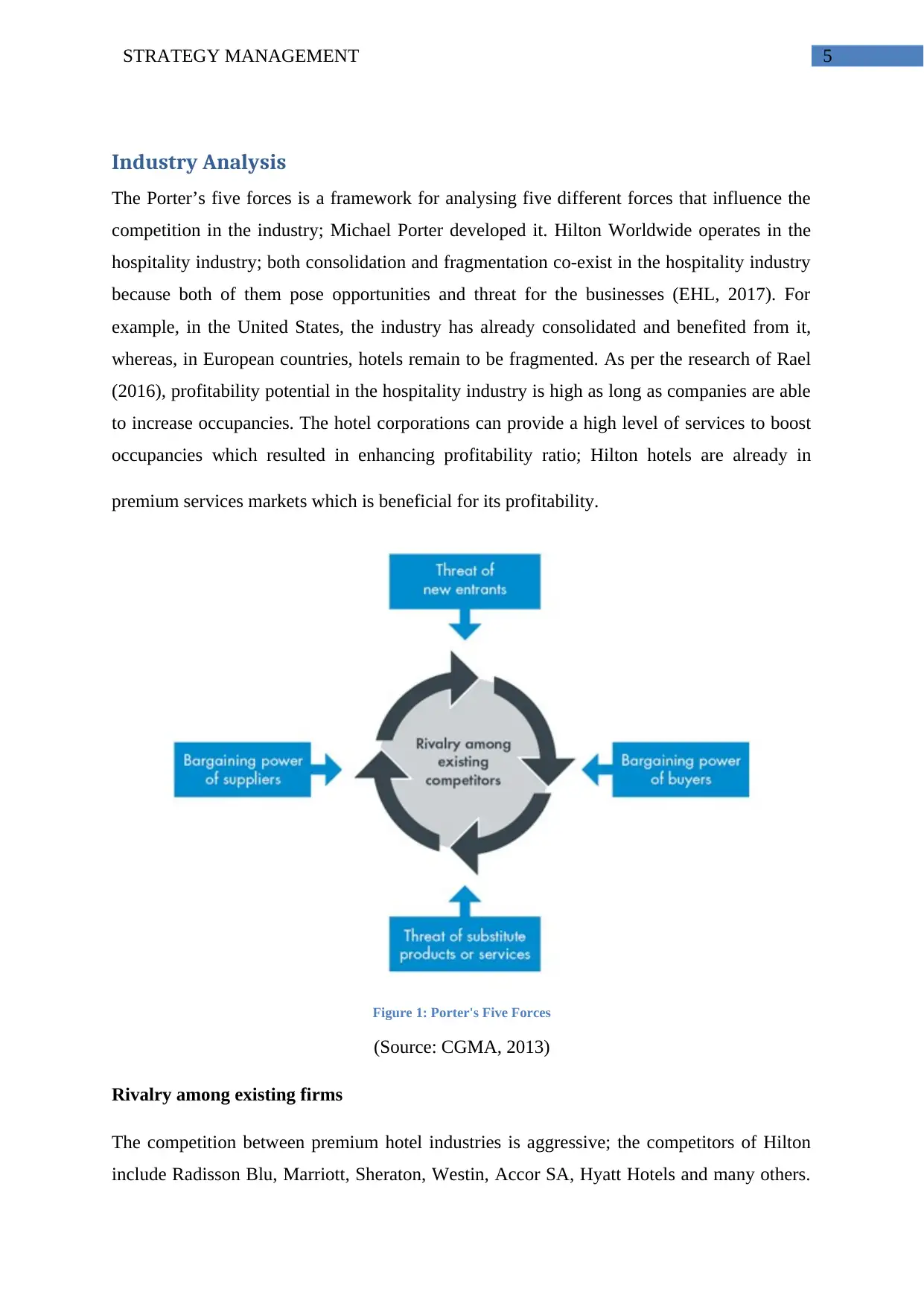
5STRATEGY MANAGEMENT
Industry Analysis
The Porter’s five forces is a framework for analysing five different forces that influence the
competition in the industry; Michael Porter developed it. Hilton Worldwide operates in the
hospitality industry; both consolidation and fragmentation co-exist in the hospitality industry
because both of them pose opportunities and threat for the businesses (EHL, 2017). For
example, in the United States, the industry has already consolidated and benefited from it,
whereas, in European countries, hotels remain to be fragmented. As per the research of Rael
(2016), profitability potential in the hospitality industry is high as long as companies are able
to increase occupancies. The hotel corporations can provide a high level of services to boost
occupancies which resulted in enhancing profitability ratio; Hilton hotels are already in
premium services markets which is beneficial for its profitability.
Figure 1: Porter's Five Forces
(Source: CGMA, 2013)
Rivalry among existing firms
The competition between premium hotel industries is aggressive; the competitors of Hilton
include Radisson Blu, Marriott, Sheraton, Westin, Accor SA, Hyatt Hotels and many others.
Industry Analysis
The Porter’s five forces is a framework for analysing five different forces that influence the
competition in the industry; Michael Porter developed it. Hilton Worldwide operates in the
hospitality industry; both consolidation and fragmentation co-exist in the hospitality industry
because both of them pose opportunities and threat for the businesses (EHL, 2017). For
example, in the United States, the industry has already consolidated and benefited from it,
whereas, in European countries, hotels remain to be fragmented. As per the research of Rael
(2016), profitability potential in the hospitality industry is high as long as companies are able
to increase occupancies. The hotel corporations can provide a high level of services to boost
occupancies which resulted in enhancing profitability ratio; Hilton hotels are already in
premium services markets which is beneficial for its profitability.
Figure 1: Porter's Five Forces
(Source: CGMA, 2013)
Rivalry among existing firms
The competition between premium hotel industries is aggressive; the competitors of Hilton
include Radisson Blu, Marriott, Sheraton, Westin, Accor SA, Hyatt Hotels and many others.
⊘ This is a preview!⊘
Do you want full access?
Subscribe today to unlock all pages.

Trusted by 1+ million students worldwide
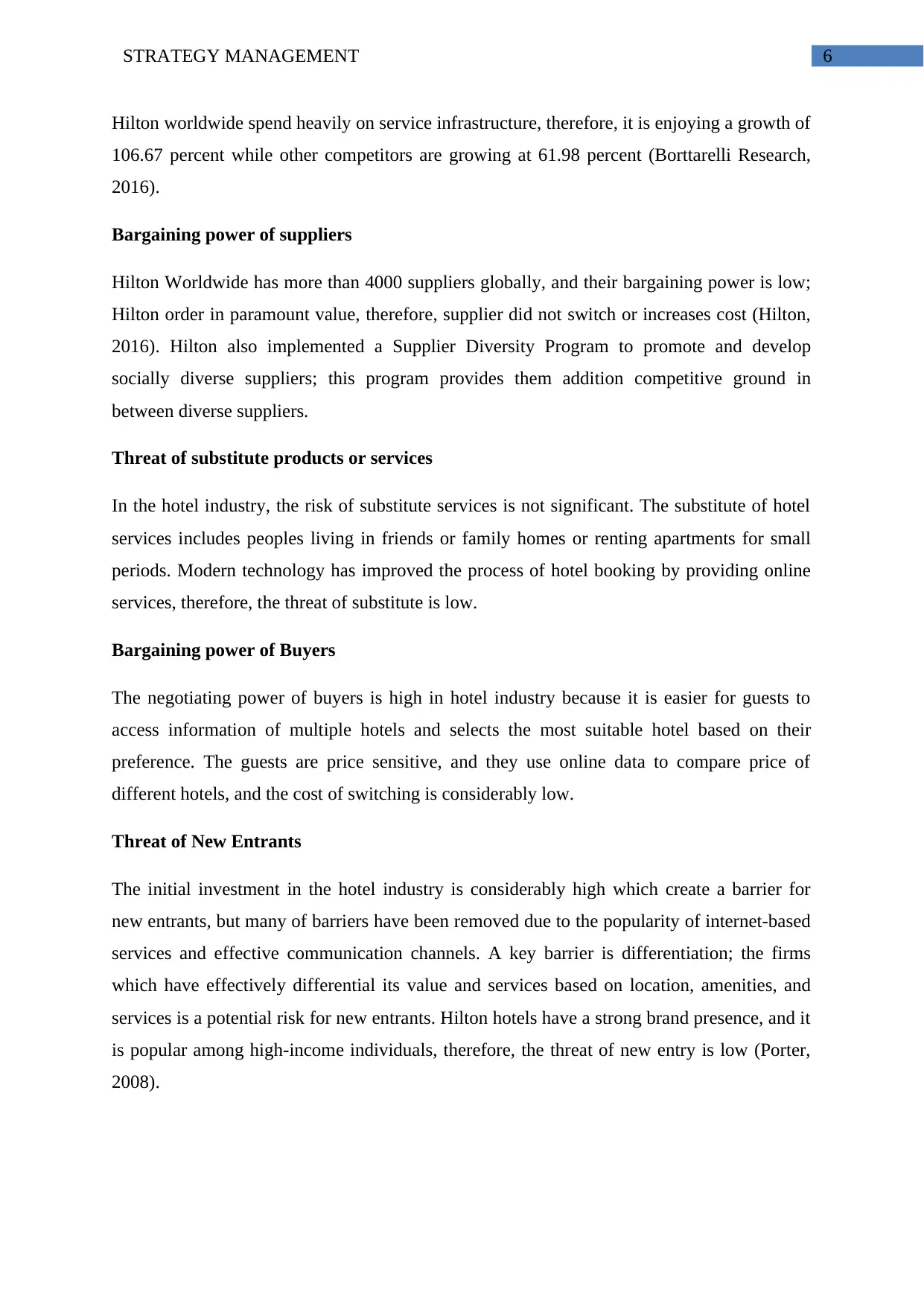
6STRATEGY MANAGEMENT
Hilton worldwide spend heavily on service infrastructure, therefore, it is enjoying a growth of
106.67 percent while other competitors are growing at 61.98 percent (Borttarelli Research,
2016).
Bargaining power of suppliers
Hilton Worldwide has more than 4000 suppliers globally, and their bargaining power is low;
Hilton order in paramount value, therefore, supplier did not switch or increases cost (Hilton,
2016). Hilton also implemented a Supplier Diversity Program to promote and develop
socially diverse suppliers; this program provides them addition competitive ground in
between diverse suppliers.
Threat of substitute products or services
In the hotel industry, the risk of substitute services is not significant. The substitute of hotel
services includes peoples living in friends or family homes or renting apartments for small
periods. Modern technology has improved the process of hotel booking by providing online
services, therefore, the threat of substitute is low.
Bargaining power of Buyers
The negotiating power of buyers is high in hotel industry because it is easier for guests to
access information of multiple hotels and selects the most suitable hotel based on their
preference. The guests are price sensitive, and they use online data to compare price of
different hotels, and the cost of switching is considerably low.
Threat of New Entrants
The initial investment in the hotel industry is considerably high which create a barrier for
new entrants, but many of barriers have been removed due to the popularity of internet-based
services and effective communication channels. A key barrier is differentiation; the firms
which have effectively differential its value and services based on location, amenities, and
services is a potential risk for new entrants. Hilton hotels have a strong brand presence, and it
is popular among high-income individuals, therefore, the threat of new entry is low (Porter,
2008).
Hilton worldwide spend heavily on service infrastructure, therefore, it is enjoying a growth of
106.67 percent while other competitors are growing at 61.98 percent (Borttarelli Research,
2016).
Bargaining power of suppliers
Hilton Worldwide has more than 4000 suppliers globally, and their bargaining power is low;
Hilton order in paramount value, therefore, supplier did not switch or increases cost (Hilton,
2016). Hilton also implemented a Supplier Diversity Program to promote and develop
socially diverse suppliers; this program provides them addition competitive ground in
between diverse suppliers.
Threat of substitute products or services
In the hotel industry, the risk of substitute services is not significant. The substitute of hotel
services includes peoples living in friends or family homes or renting apartments for small
periods. Modern technology has improved the process of hotel booking by providing online
services, therefore, the threat of substitute is low.
Bargaining power of Buyers
The negotiating power of buyers is high in hotel industry because it is easier for guests to
access information of multiple hotels and selects the most suitable hotel based on their
preference. The guests are price sensitive, and they use online data to compare price of
different hotels, and the cost of switching is considerably low.
Threat of New Entrants
The initial investment in the hotel industry is considerably high which create a barrier for
new entrants, but many of barriers have been removed due to the popularity of internet-based
services and effective communication channels. A key barrier is differentiation; the firms
which have effectively differential its value and services based on location, amenities, and
services is a potential risk for new entrants. Hilton hotels have a strong brand presence, and it
is popular among high-income individuals, therefore, the threat of new entry is low (Porter,
2008).
Paraphrase This Document
Need a fresh take? Get an instant paraphrase of this document with our AI Paraphraser
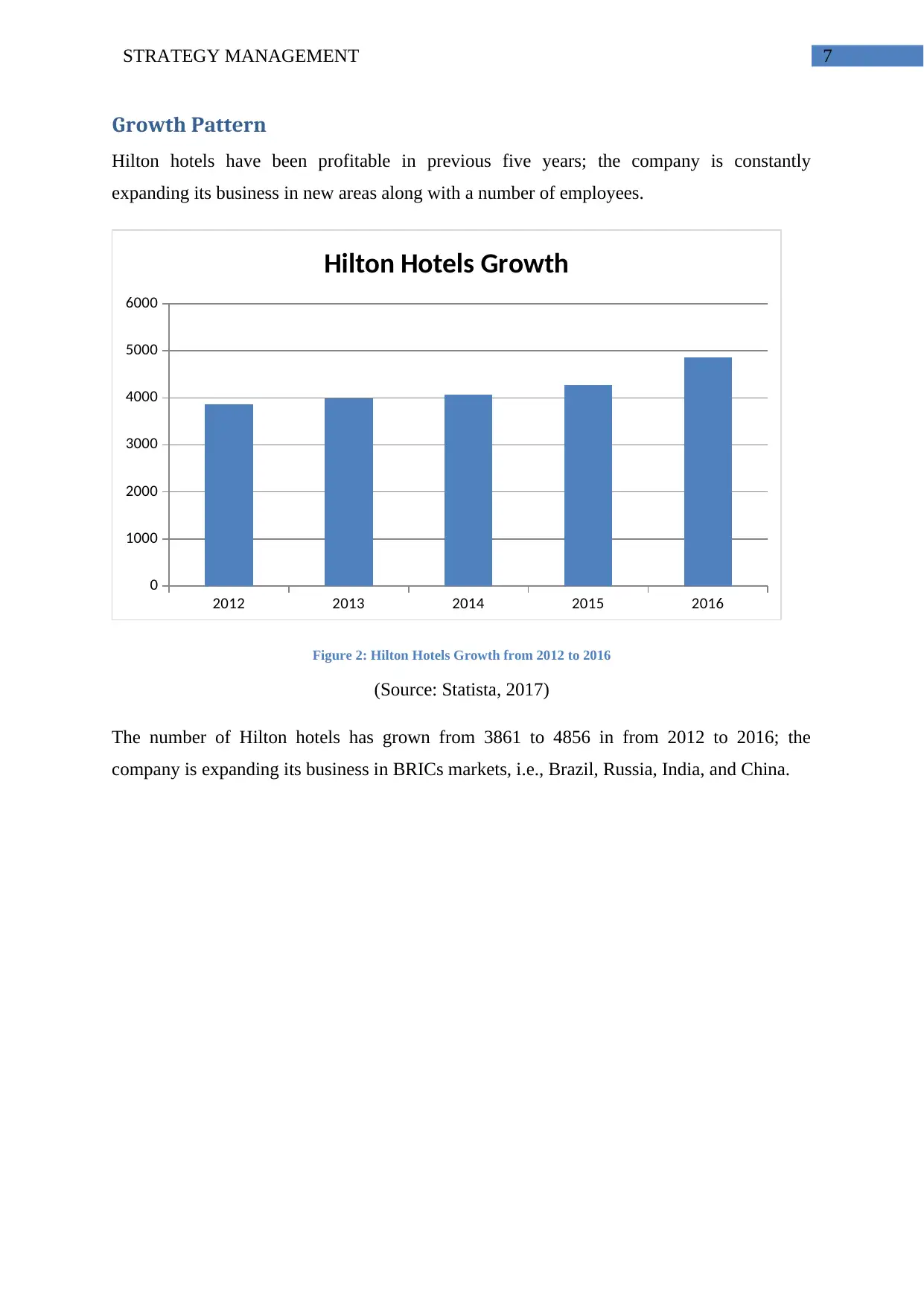
7STRATEGY MANAGEMENT
Growth Pattern
Hilton hotels have been profitable in previous five years; the company is constantly
expanding its business in new areas along with a number of employees.
2012 2013 2014 2015 2016
0
1000
2000
3000
4000
5000
6000
Hilton Hotels Growth
Figure 2: Hilton Hotels Growth from 2012 to 2016
(Source: Statista, 2017)
The number of Hilton hotels has grown from 3861 to 4856 in from 2012 to 2016; the
company is expanding its business in BRICs markets, i.e., Brazil, Russia, India, and China.
Growth Pattern
Hilton hotels have been profitable in previous five years; the company is constantly
expanding its business in new areas along with a number of employees.
2012 2013 2014 2015 2016
0
1000
2000
3000
4000
5000
6000
Hilton Hotels Growth
Figure 2: Hilton Hotels Growth from 2012 to 2016
(Source: Statista, 2017)
The number of Hilton hotels has grown from 3861 to 4856 in from 2012 to 2016; the
company is expanding its business in BRICs markets, i.e., Brazil, Russia, India, and China.
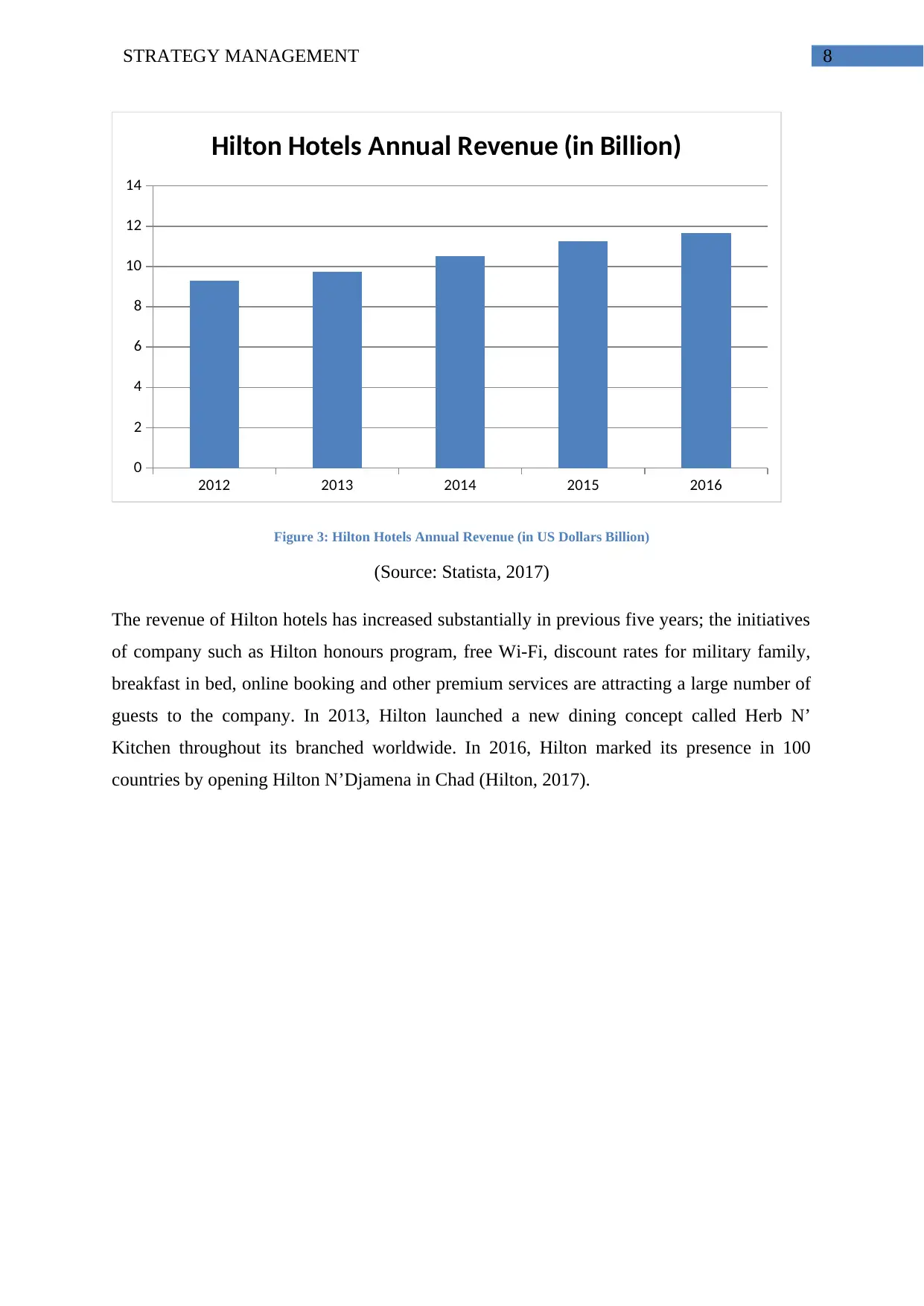
8STRATEGY MANAGEMENT
2012 2013 2014 2015 2016
0
2
4
6
8
10
12
14
Hilton Hotels Annual Revenue (in Billion)
Figure 3: Hilton Hotels Annual Revenue (in US Dollars Billion)
(Source: Statista, 2017)
The revenue of Hilton hotels has increased substantially in previous five years; the initiatives
of company such as Hilton honours program, free Wi-Fi, discount rates for military family,
breakfast in bed, online booking and other premium services are attracting a large number of
guests to the company. In 2013, Hilton launched a new dining concept called Herb N’
Kitchen throughout its branched worldwide. In 2016, Hilton marked its presence in 100
countries by opening Hilton N’Djamena in Chad (Hilton, 2017).
2012 2013 2014 2015 2016
0
2
4
6
8
10
12
14
Hilton Hotels Annual Revenue (in Billion)
Figure 3: Hilton Hotels Annual Revenue (in US Dollars Billion)
(Source: Statista, 2017)
The revenue of Hilton hotels has increased substantially in previous five years; the initiatives
of company such as Hilton honours program, free Wi-Fi, discount rates for military family,
breakfast in bed, online booking and other premium services are attracting a large number of
guests to the company. In 2013, Hilton launched a new dining concept called Herb N’
Kitchen throughout its branched worldwide. In 2016, Hilton marked its presence in 100
countries by opening Hilton N’Djamena in Chad (Hilton, 2017).
⊘ This is a preview!⊘
Do you want full access?
Subscribe today to unlock all pages.

Trusted by 1+ million students worldwide
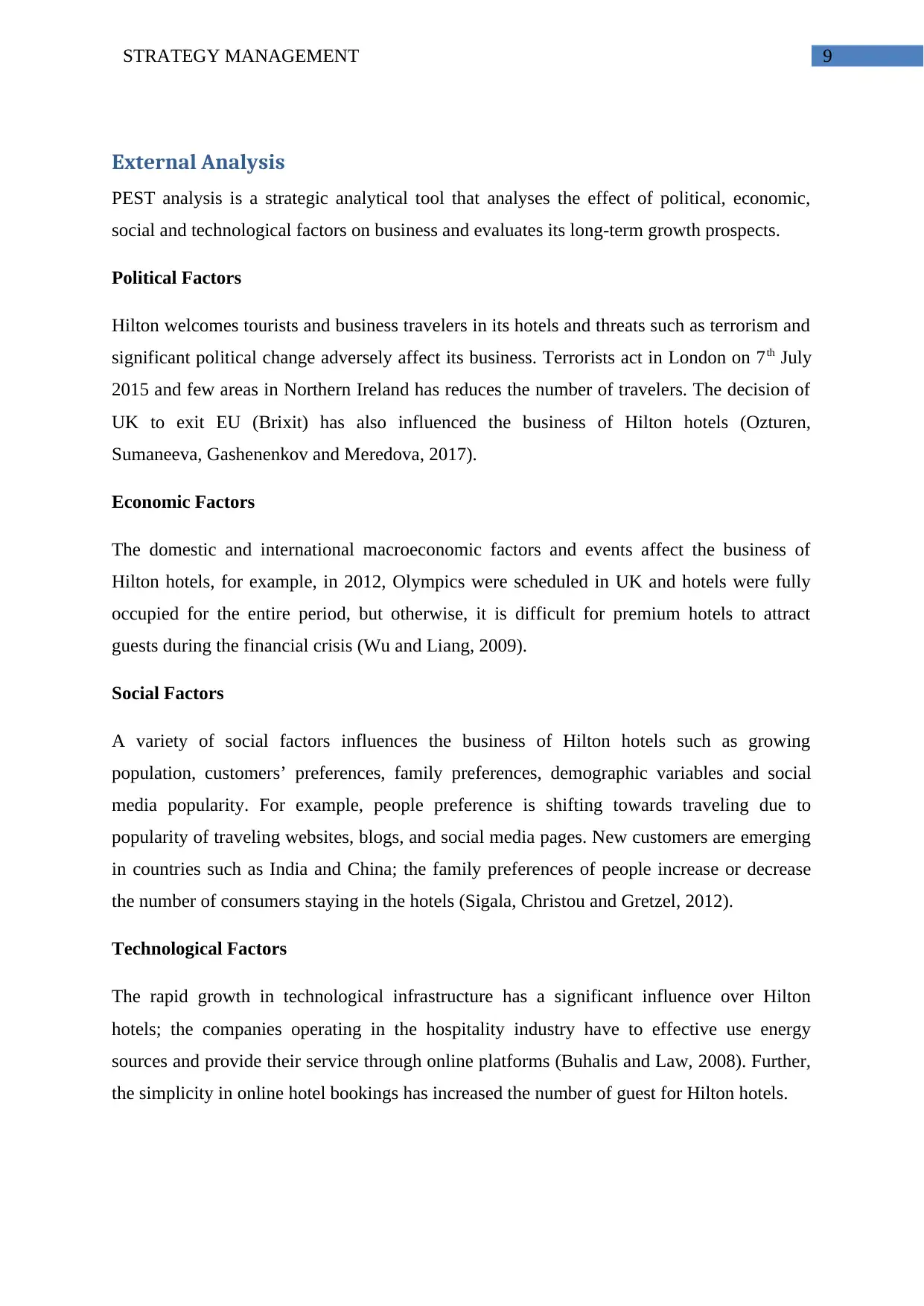
9STRATEGY MANAGEMENT
External Analysis
PEST analysis is a strategic analytical tool that analyses the effect of political, economic,
social and technological factors on business and evaluates its long-term growth prospects.
Political Factors
Hilton welcomes tourists and business travelers in its hotels and threats such as terrorism and
significant political change adversely affect its business. Terrorists act in London on 7th July
2015 and few areas in Northern Ireland has reduces the number of travelers. The decision of
UK to exit EU (Brixit) has also influenced the business of Hilton hotels (Ozturen,
Sumaneeva, Gashenenkov and Meredova, 2017).
Economic Factors
The domestic and international macroeconomic factors and events affect the business of
Hilton hotels, for example, in 2012, Olympics were scheduled in UK and hotels were fully
occupied for the entire period, but otherwise, it is difficult for premium hotels to attract
guests during the financial crisis (Wu and Liang, 2009).
Social Factors
A variety of social factors influences the business of Hilton hotels such as growing
population, customers’ preferences, family preferences, demographic variables and social
media popularity. For example, people preference is shifting towards traveling due to
popularity of traveling websites, blogs, and social media pages. New customers are emerging
in countries such as India and China; the family preferences of people increase or decrease
the number of consumers staying in the hotels (Sigala, Christou and Gretzel, 2012).
Technological Factors
The rapid growth in technological infrastructure has a significant influence over Hilton
hotels; the companies operating in the hospitality industry have to effective use energy
sources and provide their service through online platforms (Buhalis and Law, 2008). Further,
the simplicity in online hotel bookings has increased the number of guest for Hilton hotels.
External Analysis
PEST analysis is a strategic analytical tool that analyses the effect of political, economic,
social and technological factors on business and evaluates its long-term growth prospects.
Political Factors
Hilton welcomes tourists and business travelers in its hotels and threats such as terrorism and
significant political change adversely affect its business. Terrorists act in London on 7th July
2015 and few areas in Northern Ireland has reduces the number of travelers. The decision of
UK to exit EU (Brixit) has also influenced the business of Hilton hotels (Ozturen,
Sumaneeva, Gashenenkov and Meredova, 2017).
Economic Factors
The domestic and international macroeconomic factors and events affect the business of
Hilton hotels, for example, in 2012, Olympics were scheduled in UK and hotels were fully
occupied for the entire period, but otherwise, it is difficult for premium hotels to attract
guests during the financial crisis (Wu and Liang, 2009).
Social Factors
A variety of social factors influences the business of Hilton hotels such as growing
population, customers’ preferences, family preferences, demographic variables and social
media popularity. For example, people preference is shifting towards traveling due to
popularity of traveling websites, blogs, and social media pages. New customers are emerging
in countries such as India and China; the family preferences of people increase or decrease
the number of consumers staying in the hotels (Sigala, Christou and Gretzel, 2012).
Technological Factors
The rapid growth in technological infrastructure has a significant influence over Hilton
hotels; the companies operating in the hospitality industry have to effective use energy
sources and provide their service through online platforms (Buhalis and Law, 2008). Further,
the simplicity in online hotel bookings has increased the number of guest for Hilton hotels.
Paraphrase This Document
Need a fresh take? Get an instant paraphrase of this document with our AI Paraphraser
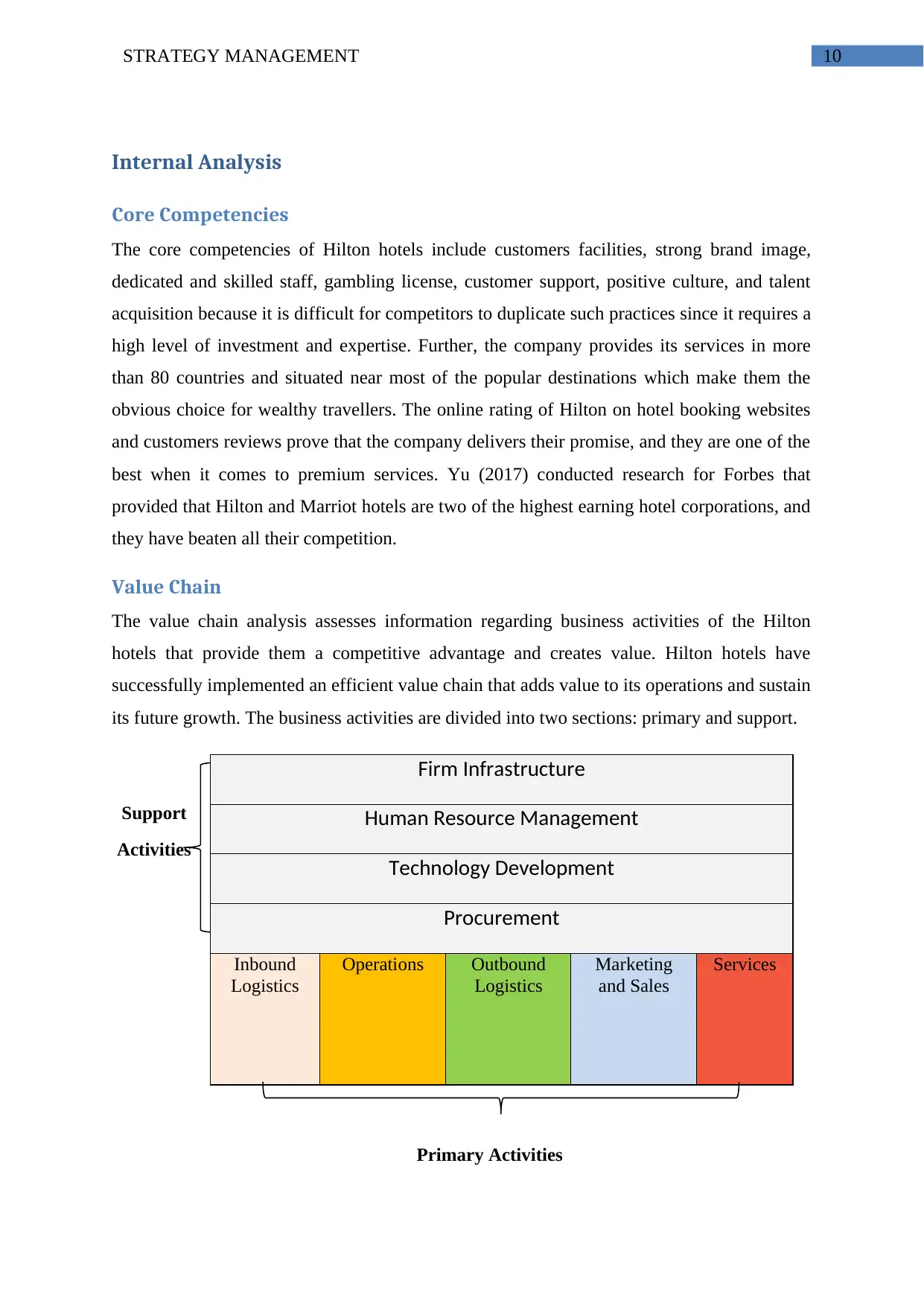
10STRATEGY MANAGEMENT
Internal Analysis
Core Competencies
The core competencies of Hilton hotels include customers facilities, strong brand image,
dedicated and skilled staff, gambling license, customer support, positive culture, and talent
acquisition because it is difficult for competitors to duplicate such practices since it requires a
high level of investment and expertise. Further, the company provides its services in more
than 80 countries and situated near most of the popular destinations which make them the
obvious choice for wealthy travellers. The online rating of Hilton on hotel booking websites
and customers reviews prove that the company delivers their promise, and they are one of the
best when it comes to premium services. Yu (2017) conducted research for Forbes that
provided that Hilton and Marriot hotels are two of the highest earning hotel corporations, and
they have beaten all their competition.
Value Chain
The value chain analysis assesses information regarding business activities of the Hilton
hotels that provide them a competitive advantage and creates value. Hilton hotels have
successfully implemented an efficient value chain that adds value to its operations and sustain
its future growth. The business activities are divided into two sections: primary and support.
Support
Activities
Primary Activities
Firm Infrastructure
Human Resource Management
Technology Development
Procurement
Inbound
Logistics
Operations Outbound
Logistics
Marketing
and Sales
Services
Internal Analysis
Core Competencies
The core competencies of Hilton hotels include customers facilities, strong brand image,
dedicated and skilled staff, gambling license, customer support, positive culture, and talent
acquisition because it is difficult for competitors to duplicate such practices since it requires a
high level of investment and expertise. Further, the company provides its services in more
than 80 countries and situated near most of the popular destinations which make them the
obvious choice for wealthy travellers. The online rating of Hilton on hotel booking websites
and customers reviews prove that the company delivers their promise, and they are one of the
best when it comes to premium services. Yu (2017) conducted research for Forbes that
provided that Hilton and Marriot hotels are two of the highest earning hotel corporations, and
they have beaten all their competition.
Value Chain
The value chain analysis assesses information regarding business activities of the Hilton
hotels that provide them a competitive advantage and creates value. Hilton hotels have
successfully implemented an efficient value chain that adds value to its operations and sustain
its future growth. The business activities are divided into two sections: primary and support.
Support
Activities
Primary Activities
Firm Infrastructure
Human Resource Management
Technology Development
Procurement
Inbound
Logistics
Operations Outbound
Logistics
Marketing
and Sales
Services
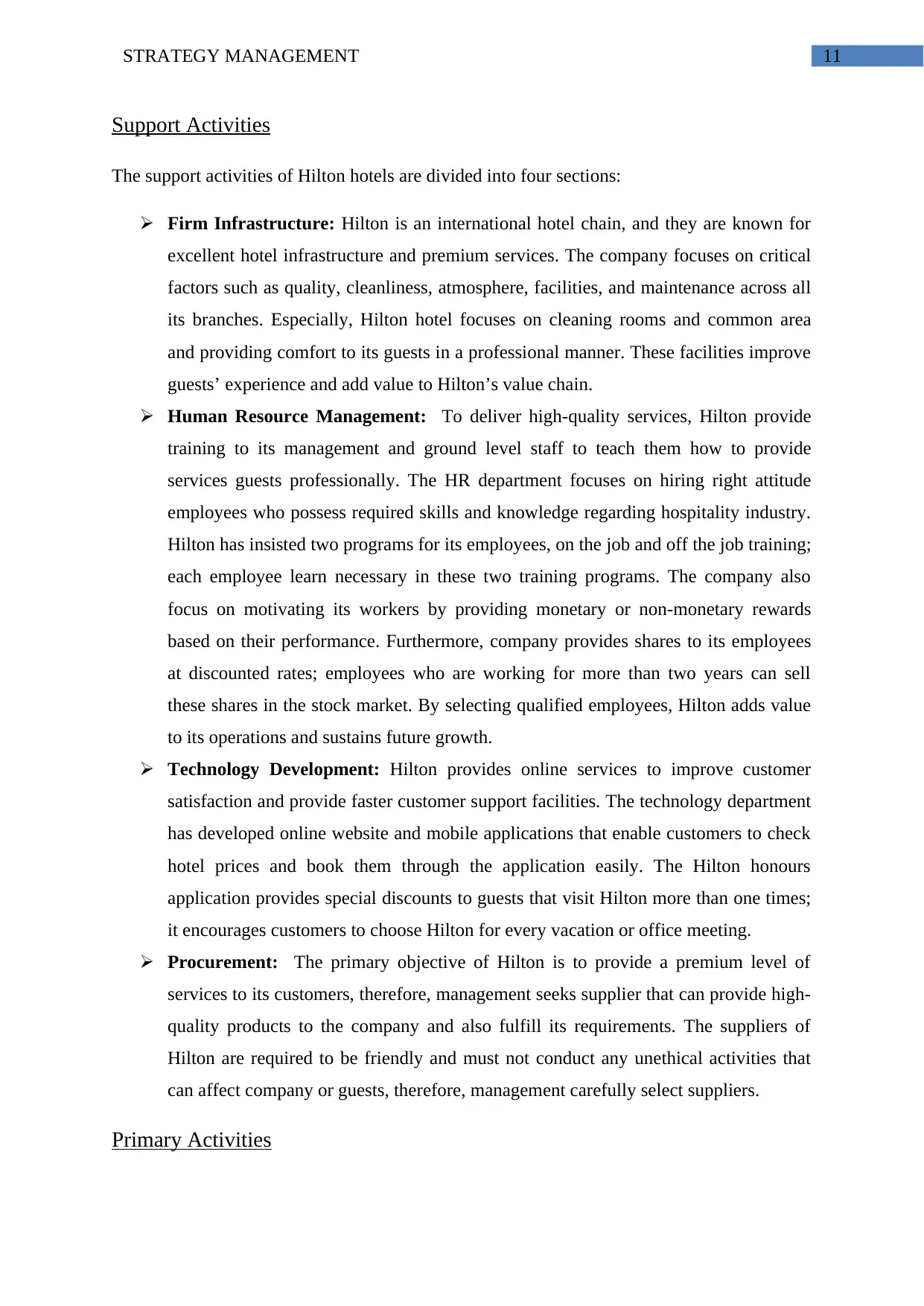
11STRATEGY MANAGEMENT
Support Activities
The support activities of Hilton hotels are divided into four sections:
Firm Infrastructure: Hilton is an international hotel chain, and they are known for
excellent hotel infrastructure and premium services. The company focuses on critical
factors such as quality, cleanliness, atmosphere, facilities, and maintenance across all
its branches. Especially, Hilton hotel focuses on cleaning rooms and common area
and providing comfort to its guests in a professional manner. These facilities improve
guests’ experience and add value to Hilton’s value chain.
Human Resource Management: To deliver high-quality services, Hilton provide
training to its management and ground level staff to teach them how to provide
services guests professionally. The HR department focuses on hiring right attitude
employees who possess required skills and knowledge regarding hospitality industry.
Hilton has insisted two programs for its employees, on the job and off the job training;
each employee learn necessary in these two training programs. The company also
focus on motivating its workers by providing monetary or non-monetary rewards
based on their performance. Furthermore, company provides shares to its employees
at discounted rates; employees who are working for more than two years can sell
these shares in the stock market. By selecting qualified employees, Hilton adds value
to its operations and sustains future growth.
Technology Development: Hilton provides online services to improve customer
satisfaction and provide faster customer support facilities. The technology department
has developed online website and mobile applications that enable customers to check
hotel prices and book them through the application easily. The Hilton honours
application provides special discounts to guests that visit Hilton more than one times;
it encourages customers to choose Hilton for every vacation or office meeting.
Procurement: The primary objective of Hilton is to provide a premium level of
services to its customers, therefore, management seeks supplier that can provide high-
quality products to the company and also fulfill its requirements. The suppliers of
Hilton are required to be friendly and must not conduct any unethical activities that
can affect company or guests, therefore, management carefully select suppliers.
Primary Activities
Support Activities
The support activities of Hilton hotels are divided into four sections:
Firm Infrastructure: Hilton is an international hotel chain, and they are known for
excellent hotel infrastructure and premium services. The company focuses on critical
factors such as quality, cleanliness, atmosphere, facilities, and maintenance across all
its branches. Especially, Hilton hotel focuses on cleaning rooms and common area
and providing comfort to its guests in a professional manner. These facilities improve
guests’ experience and add value to Hilton’s value chain.
Human Resource Management: To deliver high-quality services, Hilton provide
training to its management and ground level staff to teach them how to provide
services guests professionally. The HR department focuses on hiring right attitude
employees who possess required skills and knowledge regarding hospitality industry.
Hilton has insisted two programs for its employees, on the job and off the job training;
each employee learn necessary in these two training programs. The company also
focus on motivating its workers by providing monetary or non-monetary rewards
based on their performance. Furthermore, company provides shares to its employees
at discounted rates; employees who are working for more than two years can sell
these shares in the stock market. By selecting qualified employees, Hilton adds value
to its operations and sustains future growth.
Technology Development: Hilton provides online services to improve customer
satisfaction and provide faster customer support facilities. The technology department
has developed online website and mobile applications that enable customers to check
hotel prices and book them through the application easily. The Hilton honours
application provides special discounts to guests that visit Hilton more than one times;
it encourages customers to choose Hilton for every vacation or office meeting.
Procurement: The primary objective of Hilton is to provide a premium level of
services to its customers, therefore, management seeks supplier that can provide high-
quality products to the company and also fulfill its requirements. The suppliers of
Hilton are required to be friendly and must not conduct any unethical activities that
can affect company or guests, therefore, management carefully select suppliers.
Primary Activities
⊘ This is a preview!⊘
Do you want full access?
Subscribe today to unlock all pages.

Trusted by 1+ million students worldwide
1 out of 21
Related Documents
Your All-in-One AI-Powered Toolkit for Academic Success.
+13062052269
info@desklib.com
Available 24*7 on WhatsApp / Email
![[object Object]](/_next/static/media/star-bottom.7253800d.svg)
Unlock your academic potential
Copyright © 2020–2025 A2Z Services. All Rights Reserved. Developed and managed by ZUCOL.





